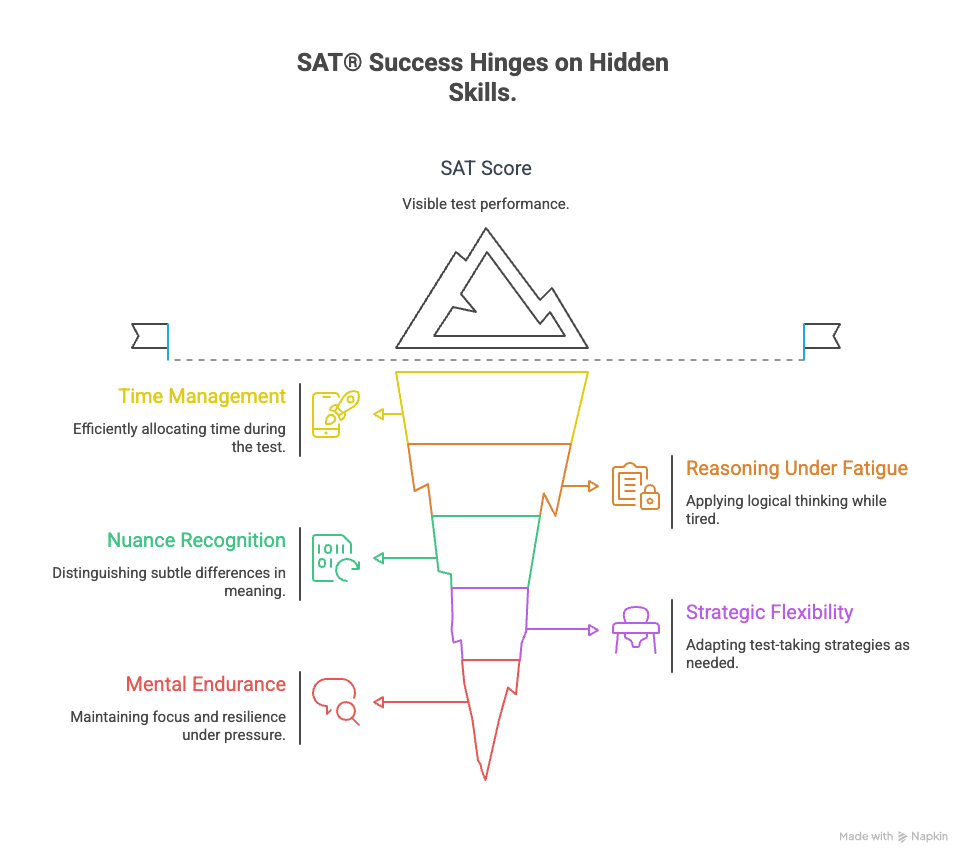Most students build their study routine around good intentions. They plan for energy, clarity, and focus for their SAT® prep. But real life doesn’t work that way.
You’ll get sick. You’ll lose motivation. You’ll have a rough week, a bad day, or a crash that takes longer to recover from than you thought.
And when that happens, most SAT® study strategies fall apart. Not because you’re weak, but because they were never designed to bend without breaking.
This isn’t about motivation. It’s about designing for volatility when it comes to your SAT® prep and mental resilience.
The Problem with Goal-Based Studying for SAT® Prep
Goals feel clear, like "Study 3 hours every day for the SAT®." But when you miss one, your brain jumps to all-or-nothing logic:
- "I broke the streak. Might as well restart Monday."
- "I didn’t do anything today. I’m falling behind. I’ll catch up later."
This is what James Clear, author of Atomic Habits, calls the "yo-yo effect of high expectation." You aim high, miss, then spiral.
And it’s avoidable, but only if you stop thinking in goals and start thinking in systems for your SAT® study strategies.
Systems vs. Goals: Why the Shift Matters for SAT® Study Strategies
- A system is a process: "I study for the SAT® at 6 p.m. with no phone nearby, even if I only do one question."
- A goal is a target: "Finish 5 SAT® sections this week."
Goals are fragile. Systems are flexible. And flexibility is what saves your SAT® prep when chaos hits.
Stoic philosophy has a term for this: premeditatio malorum. It's the practice of imagining things going wrong in advance, so you’re not paralyzed when they do.
You don’t build a perfect routine for the SAT®. You build one that survives failure. This is fundamental to SAT® and mental resilience.
What a Resilient SAT® Study System Looks Like
1. It Has a Minimum Viable Version for SAT® Prep
A minimum viable study routine is what you do on bad days. Not your best. Your baseline for SAT® prep:
- Ideal: 1 full SAT® section + review
- Functional: 25 minutes of practice + 5-minute summary
- Minimum viable: Open book, read one problem, close it. That’s it.
Why this matters: On bad days, doing something protects your rhythm. It keeps SAT® study tied to identity, not outcomes, boosting your mental resilience.
2. It’s Time-Linked, Not Task-Dependent for SAT® Study Strategies
Most students think in tasks: "Finish this SAT® unit." But life doesn’t give you fixed units. It gives you time.
Try this: Study for the SAT® from 6:30 to 7:00 p.m. every weekday, no matter what you do in that time. Sometimes it’s full practice. Sometimes it’s flashcards. Sometimes it’s nothing but sitting with your book open and taking a breath.
Time-linking gives you consistency without rigidity, which is a powerful SAT® study strategy.
3. It Accounts for Energy, Not Just Willpower for SAT® and Mental Resilience
Burnout doesn’t always look dramatic. Sometimes it’s just you staring at an SAT® page for 20 minutes and understanding nothing.
Try this: Build your week like an athlete, not a robot, for your SAT® prep.
- Friday: Reflect, rest, reset.
- Monday: High cognitive load for SAT® content.
- Wednesday: Low-stakes review of SAT® concepts.
Use your Sherpalai Persona and consistency data to map energy rhythms, not just hours spent. This personalized approach enhances your SAT® and mental resilience.
4. It Prepares You to Restart Without Shame in Your SAT® Prep
The best SAT® study systems assume you’ll break them.
Try this: Write down one line now: "When I miss a day of SAT® prep, I resume without explanation." Not to journal about. Not to overthink. Just to normalize.
That line removes the shame spiral that kills momentum and protects your SAT® and mental resilience.
.png)





